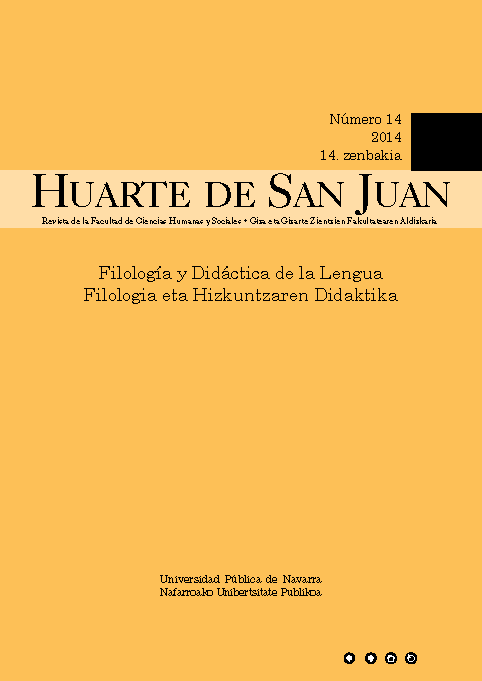Factores externos en la percepción de las consonantes silábicas y la schwa en inglés
Keywords:
English syllabic consonants, schwa, perception, speaking rhythm, word position, word emphasisAbstract
This paper deals with the perception of English syllabic consonants vs. schwa finally in a word at discourse level. The fact that these phonemes are constantly present in speech (Trask 1996) and the lack of studies which focus on their perception (see, however, van Bergem 1995) make further exploration eligible. The informants for this study were 80 non-rhotic native newsreaders (40 males and 40 females) taken from the BBC Learning English website (2009). Three female listeners not knowledgeable about the purposes of the study had to decide whether they perceived a schwa or a syllabic consonant in 800 words. The data were analysed with the help of SPSS. The statistical procedures used were chi-square tests and Kendall’s coefficients of concordance. Results revealed that word emphasis is statistically associated with the perception of syllabic consonants and schwa and the referees employ different assessment criteria in terms of word position.
Downloads
References
ARBOLEDA, I. DE J. (2012): «Do people selectively interpret their schwa vs. syllabic consonant perception on the basis of their background, experience and expectations?», Revista de Lingüística y Lenguas Aplicadas, 7: 23-35. [http://dx.doi.org/10.4995/rlyla.2012.1122].
BALASUBRAMANIAN, T. (1981): «Emphasis in Tamil», Journal of Phonetics, 9, 2.
BBC Learning English Website (2009 [http://www.bbc.co.uk/worldservice/learningenglish/index.shtml] [accedida 8 mayo 2012].
BERG, T. (1998): Linguistic structure and change: An explanation from language processing, Oxford, Oxford University Press.
VAN BERGEM, D. R. (1995): «Perceptual and acoustic aspects of lexical vowel reduction, a sound change in progress», Speech Communication, 16: 4, 329-358.
BHATIA, T. K. (1973): «A computational investigation on the perception and acquisition of aspiration», Actas de 5th Conference on Computational Linguistics, vol. 2, Pisa, 33-35.
BROWN, A. (ed.) (1991): Teaching English pronunciation, Londres, Routledge. Cambridge Advanced Learner’s Dictionary (2008): Cambridge, Cambridge University Press.
CRUTTENDEN, A. (2001): Gimson’s pronunciation of English, 6ª ed. revisada por Alan Cruttenden, Londres, Arnold.
DETERDING, D. (2006): «Deletion of final /t/ and /d/ in BBC English: Implications for teachers in Singapore», STETS Language & Communication Review, 5: 1, 21-24.
DIEHL, R. L.; LOTTO, A. J. y HOLT, L. L. (2004): «Speech perception», Annual Review of Psychology, 55, 149-179.
GARCÍA, E. (2006): «The perception of lateral versus nasal syllabic resonants» [http://www.haskins.yale.edu/SR/SR013/SR013_06.pdf] [accedida 21 julio 2012].
GIMSON, A. C. (1970): An introduction to the pronunciation of English, Londres, University of London Press.
GOTTFRIED, T. L.; BOSTON, M.; MILLER, J. L. y PAYTON, P. E. (1990): «Effect of speaking rate on the perception of vowels», Phonetica, 47: 3-4, 155-172.
HARRINGTON, J. (2006): «An acoustic analysis of ‘happy-tensing’ in the Queen’s Christmas broadcasts», Journal of Phonetics, 34: 4, 439-457.
MCENERY, T.; XIAO, R. y TONIO, Y. (2006): Corpus-based language studies: An advanced resource book, Nueva York, Routledge.
MILLER, J. L. y BOSTON, M. (1981): «Some effects of speaking rate on phonetic perception», Phonetica, 38: 1-3, 159-180.
MOMPEÁN, P. y MOMPEÁN, J. A. (2006): «Intrusive /r/ usage in RP: The case of BBC newsreaders», V International Conference of the Spanish Cognitive Linguistics, Murcia.
MOMPEÁN, P. y MOMPEÁN, J. A. (2007): «Phonetic factors in /r/-liaison usage: A first report», en J. Trouvain y W.J. Barry (eds.), Actas del 16th International Congress of Phonetic Sciences, Universität des Saarlandes, Saarbrücken, 1397-1400.
MONROY, R. (1980): La pronunciación del inglés RP para hablantes de español, Madrid, Paraninfo.
MONROY, R. (2008-2009): Fonética inglesa [Material de clase], Murcia, UMU.
ORTLEB, R. (1937): «An objective study of emphasis in oral reading of emotional and unemotional material», Speech Monographs, 4.
O’SHAUGHNESSY, D. (1981): «A study of French vowel and consonant durations», Journal of Phonetics, 9, 385-406.
REICH, S. S. (1980): «Significance of pauses for speech», Journal of Psycholinguistic Research, 9: 4, 379-389.
ROACH, P. (1987): English phonetics and phonology: A practical course, Cambridge, Cambridge University Press.
ROACH, P. (2000): English phonetics and phonology: A practical course, Cambridge, Cambridge University Press.
ROACH, P. (2002): A little encyclopedia of phonetics, Cambridge, Cambridge University Press.
SCHAEFFERN, N. y EICHORN, N. (2001): «The effects of differential vowel prolongations on perceptions of speech naturalness», Journal of Fluency Disorders, 26: 4, 335-348.
SPSS, Inc., an IBM Company (1989, 2010): IBM SPSS statistics version 19.0.0., Chicago, SPSS, Inc., an IBM Company.
TÖFT, Z. (2002): «The phonetics and phonology of some syllabic consonants in Southern British English», ZAS Papers in Linguistics, 28, 111-44.
TRASK, R. L. (1996): Dictionary of phonetics and phonology, Londres-Nueva York, Routledge.
WELLS, J. C. (1965): «The phonological status of syllabic consonants in English RP.», Phonetica, 13, 110-113.
ZEBROWITZ-MCCARTHUR, L. y POST, D. (1977): «Figural emphasis and person perception», Journal of Experimental Social Psychology, 13, 520-535.
Downloads
Published
How to Cite
Issue
Section
License
All articles are published under a Creative Commons (BY-NC-ND 4.0) license. Each article will be assigned a DOI.
Authors retain copyright of their work and grant the journal the right to the first publication. Authors can sign additional agreements to non-exclusive distribution of the published version of the article (for example, in an institutional repository) as long as appropriate attribution to the original publication is provided. Articles can be uploaded to institutional repositories immediately after publication.
Electronic distribution of the articles (for example, academic social networks or personal webpages) is allowed and encouraged.
The journal reserves the right to publicise the work in social networks and other electronic means.







